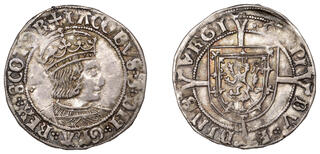| Noonans (formerly Dix Noonan Webb) > Auction 286 | Auction date: 24 January 2024 |
| Lot number: 154 Price realized: 750 GBP (Approx. 950 USD / 877 EUR) Note: Prices do not include buyer's fees. | Show similar lots on CoinArchives Find similar lots in upcoming auctions on |
| Lot description: A Collection of Scottish Coins, the Property of a Gentleman (Part I) James V (1513-1542), Second coinage, Groat, Holyrood Abbey mint, type IIIa (ii), bust right with wide-collared mantle and double-arched crown, nine jewels to band, strawberry-leaf decorations, trefoil of pellets behind head, rev. shield with rounded base, cross-ends D, pelleted v in oppidv, contraction after r of edinbvrgi, trefoil stops both sides, 2.63g/12h (SCBI 35, 936, same obv. die; SCBI 58, 67; SCBI 71, 372; cf. B 17, fig. 718; S 5378). Good very fine £600-£800 --- Provenance: Revd J.H. Pollexfen Collection, Sotheby Auction, 26-28 June 1900, lot 317; Lord Grantley Collection, Part V, Glendining Auction, 18-19 May 1944, lot 1754 (part); R.C. Lockett Collection, Part I, Glendining Auction, 18-19 June 1957, lot 296 [or 297?] (part); A Distinguished Collection of Scottish Coins and Medals, Spink Auction 20, 31 March 1982, lot 150 The first numismatic indication of an Edinburgh mint situated other than in Edinburgh Castle comes with the name Abbey Crowns - referring to the gold coinage of James V introduced in 1526. Their legends also refer to the Holy Cross (Rood). Holyrood Palace, as begun by James IV, was completed in 1505, though much extended during his son's reign. The mint, apparently situated in the outer court of the palace on the south side of the Canongate, may have been established at this time. The abbey is mentioned in connection with coin dies as early as 1502 and Matthew Auchinleck, a moneyer up until 1507, was a Burgess of Canongate. [Abridged from Lord Stewartby's article 'Scottish Mints' (Mint Dies and Currency pp.244-5)] |  |


